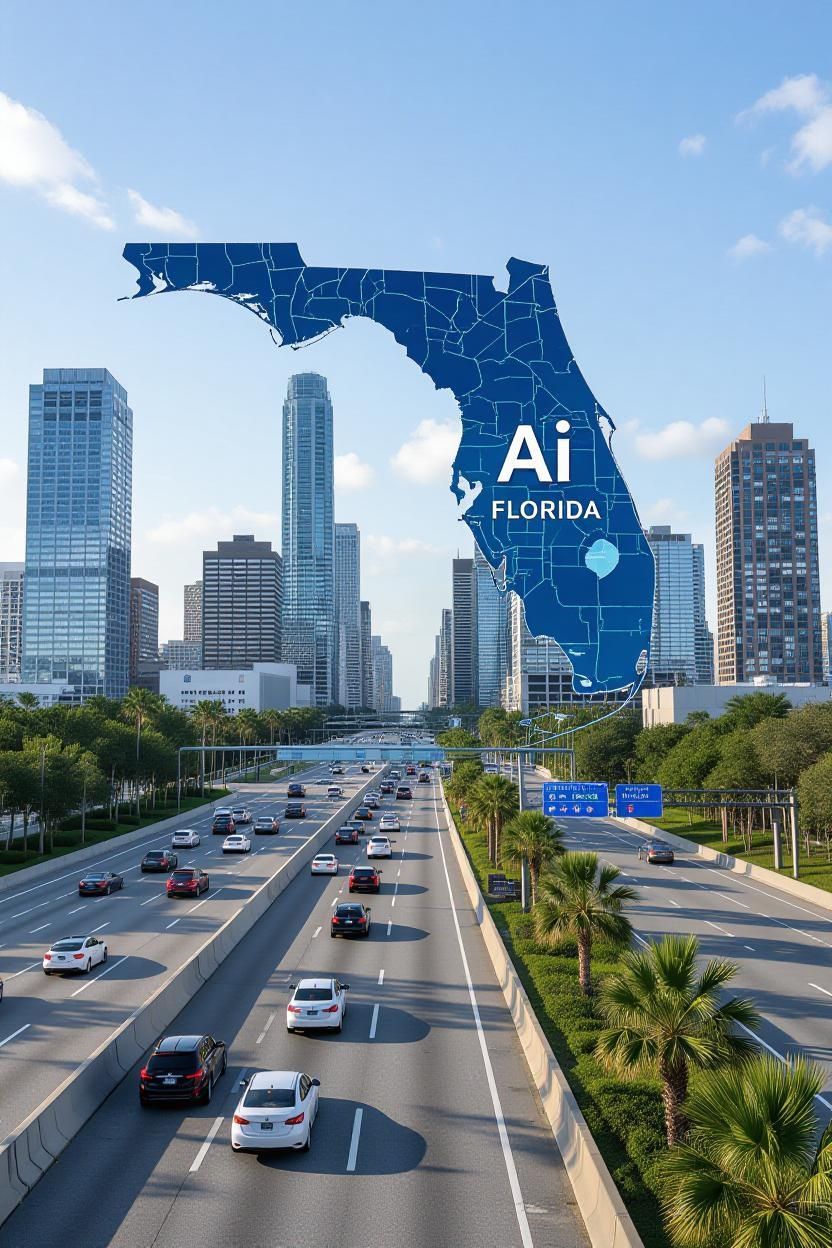Enterprise Expertise for Main Street: Why Small Businesses Deserve Better Than Scaled-Down Solutions
By Jason+ Wade • November 10, 2025

Enterprise Expertise for Main Street: Why Small Businesses Deserve Better Than Scaled-Down Solutions
TLDR
Cody Johnston spent 10+ years solving enterprise-level problems for government agencies and Fortune 500 companies. In May 2025, he launched The Weird Canadian to bring that expertise directly to startups, small companies, and nonprofits—proving that enterprise-quality solutions don't require enterprise budgets. The gap between what big companies can afford and what small businesses actually need has created an opportunity for leaders who understand both worlds.
Table of Contents
1. The Gap Nobody's Talking About
2. From Government Systems to Main Street Solutions
3. What Enterprise Really Means (And Why It Matters)
4. The Banking Platform Years: Learning at Scale
5. Why Small Business Isn't Just Scaled-Down Enterprise
6. The Rural Reality: Understanding Main Street from Ground Level
7. The Weird Canadian: Bridging the Expertise Gap
8. Business Strategy That Actually Works
9. Custom Development for Real Constraints
10. Content Creation and Coaching as Multipliers
11. The Future of Main Street Innovation
The Gap Nobody's Talking About
There's a fundamental disconnect in how business services are marketed and delivered in North America. On one end, you have enterprises—massive organizations with dedicated IT departments, six-figure budgets for vendors, and the luxury of a two-year implementation timeline. On the other end, you have Main Street: small businesses, startups, and nonprofits that need sophisticated solutions yesterday, working with budgets that don't even register at enterprise software companies.
The problem isn't that these smaller organizations don't have problems worth solving. They absolutely do. They're managing cash flow across multiple channels, scaling operations without breaking their systems, navigating compliance requirements that get more complex every year, and trying to compete against larger players who have invested millions in their infrastructure. The real problem is that most solutions available to them are either generic, watered-down versions of enterprise tools, or they're just... not designed for the reality small business operates in.
This gap is where Cody Johnston's 10+ years of experience becomes invaluable. He's spent nearly a decade and a half inside the systems that work at scale—watching how government agencies manage mission-critical infrastructure and how Fortune 500 companies solve problems that would bankrupt smaller organizations if they got them wrong. And he's realized something crucial: many of those sophisticated solutions can be adapted, scaled down thoughtfully, and delivered in ways that actually fit how small businesses operate.
**Key Point #1: The expertise gap between enterprise and Main Street is not just about budget—it's about understanding what actually works when resources are constrained.**
From Government Systems to Main Street Solutions
Cody's journey into technology started at 16 with coding, but his real education came through eight years with Ontario's Ministry of Transportation from 2016 to 2024. If you've never thought about what goes into running transportation systems for an entire province, here's a snapshot: it's complex. It's mission-critical. It's regulated. And it's the kind of work where your mistakes don't just cost money—they affect real people trying to move around their province.
Working within government systems teaches you things that university never will. You learn how to navigate bureaucracy without letting it paralyze you. You learn how compliance actually works, not just as a checkbox but as an integrated part of system design. You learn how to manage stakeholders with competing priorities, balance security with usability, and maintain systems that have to work reliably 24/7 without excuses.
Key Point #2: Government work teaches problem-solving at the systems level—not just writing code, but understanding how technology fits into larger organizational needs.**
The Ministry of Transportation experience wasn't just about transportation systems either. It was about understanding how to think like an enterprise architect—how to plan for scale, anticipate failure points, build redundancy, and create systems that don't just work today but can evolve as requirements change. These aren't abstract principles. They're hard-won lessons from working in environments where failure isn't an option.
After eight years building those systems, Cody moved to FIS Global in 2024, spending a year building banking platforms. If government work teaches you about compliance and mission-critical infrastructure, banking teaches you about the consequences of getting things wrong at scale. Banks process billions in transactions daily. Systems have to work. Security isn't optional. Compliance isn't aspirational. And the customers—both the banks and their users—expect reliability that borders on the miraculous.
What Enterprise Really Means (And Why It Matters)
Here's something that gets lost in the marketing: "enterprise" doesn't just mean "big." It means something very specific about how problems are solved. Enterprise thinking is about building systems that don't break when conditions change. It's about planning for scale before you need it. It's about security and compliance integrated into architecture, not bolted on after the fact. It's about understanding that today's solution needs to handle tomorrow's growth without a complete rewrite.
Most small businesses aren't thinking in those terms because they can't afford to. They're solving today's problem with today's constraints, hoping they can scale later. That's a reasonable approach when you're bootstrapped, but it creates technical debt that compounds. Every workaround, every shortcut, every "we'll refactor this later" decision becomes harder to undo as the business grows.
Key Point #3: Enterprise thinking isn't wasteful complexity—it's the pattern-based approach to solving problems that prevents future crises.**
The gap between how enterprises approach problems and how Main Street has to approach them is real, but it's not insurmountable. The key is translating enterprise principles into Main Street constraints. It means asking: "What parts of this approach actually matter for our situation?" and "How do we get 80% of the benefit without 100% of the complexity and cost?"
This is what differentiates someone with actual enterprise experience from someone who just learned a tech stack and started freelancing. It's not arrogance about big companies doing things better. It's understanding which problems actually need enterprise-level thinking and which ones can be solved more pragmatically for smaller organizations.
The Banking Platform Years: Learning at Scale
After nearly a decade in government, Cody took his expertise into the financial services sector at FIS Global. If you're not familiar with FIS, they're a global leader in banking software—the kind of company where thousands of banks depend on their platforms to process transactions, manage security, handle compliance, and keep the financial system moving.
A year at FIS Global isn't a long tenure, but the educational value is enormous. Banking platforms exist at the intersection of everything that matters: security, scale, compliance, user experience, and the absolute requirement that everything works. You can't have a banking system that "mostly works." You can't have outages. You can't have security vulnerabilities. The tolerance for failure is essentially zero.
Key Point #4: Banking experience teaches you to think about systems in terms of failure modes and how to design to prevent catastrophic outcomes.**
Working on banking platforms meant understanding how regulatory requirements like Know Your Customer (KYC), Anti-Money Laundering (AML), and Payment Card Industry (PCI) compliance aren't just legal requirements—they're fundamental to how the system needs to be designed. It meant learning how to handle the exponential increase in complexity that comes with scale. A system that works fine processing 1,000 transactions per day might collapse at 100,000 transactions per day if it wasn't designed with that scale in mind.
For Main Street businesses, these lessons translate into practical advice: design your systems with your future growth in mind, even if you don't think you'll hit it. Think about security not as an afterthought but as part of your foundational architecture. Understand your compliance requirements early, not as audit-time discoveries. Build for reliability.
Why Small Business Isn't Just Scaled-Down Enterprise
This is where conventional wisdom gets it wrong. Many consultants and service providers approach small business as "enterprise, but cheaper." They take enterprise approaches and try to strip out costs. It doesn't work because the constraints are fundamentally different.
An enterprise has dedicated IT staff who can spend three weeks implementing a new system. A small business has a founder wearing fifteen hats who needs something operational by Monday. An enterprise can absorb a two-week learning curve on new software. A small business needs something intuitive enough that they can learn it while doing their actual job. An enterprise can justify a $100,000 platform license because they're processing millions in transactions. A small business needs the same capabilities delivered for a fraction of the cost.
Key Point #5: Understanding small business constraints isn't about making enterprise solutions cheaper—it's about solving problems with a completely different architecture and approach.
The real expertise isn't dumbing down solutions. It's knowing which enterprise principles actually transfer to smaller organizations and which ones need to be fundamentally reimagined. It's understanding that a small business owner needs business strategy that's executable by a single person or a small team, not strategy documents that require a project management office to implement.
This is why so many vendor relationships fail for small businesses. They buy enterprise software designed for large teams and then struggle because the software assumes capabilities they don't have. They get consulting advice designed for companies with hundreds of employees and can't figure out how to apply it in a 5-person company. They read best practices written for large organizations and feel inadequate because they can't implement them as written.
The Rural Reality: Understanding Main Street from Ground Level
Understanding small business constraints becomes clearer when you're operating in a small rural town where those constraints are even more pronounced. Cody's firsthand experience reveals challenges that many consultants never encounter. In his local market, estimates suggest 50-60% of local businesses either have no website or operate outdated 1990s-style sites. Facebook remains the dominant platform where local businesses actually conduct transactions and reach customers. Older business owners (60-70 years old) who are comfortable with current revenue levels often see technology not as an opportunity but as unnecessary disruption.
These aren't abstract challenges. They're the reality of Main Street in regions where infrastructure itself is constrained. Limited road access to northern regions requires flights for deliveries or meetings. Ferry system constraints affect economic development and supply chains. Population is concentrated along the southern border with vast underutilized land that could support economic activity if connected properly to markets and information.
Key Point #9: Understanding Main Street economics requires understanding infrastructure realities—what works in urban centers often doesn't translate to rural or underconnected regions.
This context has shaped Cody's approach fundamentally. He's not advocating that every business needs a sophisticated digital presence overnight. He's recognizing that technology adoption follows different patterns in different communities. His work as tourism coordinator for his local town—appointed to establish and coordinate all online tourism activities—brings this expertise directly into practice. He's building systems and strategies that work for communities, not against them.
The applications he builds prioritize legacy value propositions rather than growth-at-all-costs narratives. He frames technology upgrades as tools for business succession and legacy building, targeting business owners considering retirement or succession planning. This is sophisticated business strategy applied to real community needs.
The Weird Canadian: Bridging the Expertise Gap
In May 2025, Cody launched The Weird Canadian—a response to years of watching smart, capable small business owners and nonprofits struggle with problems he knew how to solve. Operating from a small rural town in Canada, he's been helping local businesses with websites, automation, and custom applications while simultaneously building a practice that reaches across North America. The name itself is an inside joke about Canadian politeness mixed with a willingness to do things differently, but the mission is serious: bring enterprise-level expertise to organizations that don't have enterprise resources. You can find him at **theweirdcanadian.ca**, and his work also extends through **AiMainStreets.com** and **NinjaAI.com**, where he addresses the specific challenges facing Main Street businesses.
Key Point #6: The Weird Canadian isn't a consulting firm downsizing enterprise approaches—it's a specialized practice built around what Main Street actually needs.
The Weird Canadian operates across four primary service areas: business strategy, custom development, content creation, and coaching. Each of these is about translating expertise into formats that work for small organizations.
Business strategy from Cody isn't a hundred-page strategic plan that gets filed away. It's executable strategy—here's what you need to focus on, here's why it matters, here's how you actually do it with your current resources. It's the kind of strategy that a founder can act on immediately.
Custom development means building solutions that fit your specific constraints. It means understanding that you might not need a system that handles 1 million transactions per day—you need a system that handles your 100 transactions per day reliably and can grow to 10,000 when you're ready. It means shipping working solutions quickly rather than lengthy implementation timelines.
Content creation and coaching are about multiplying impact. A founder can't be everywhere at once, so content allows them to share their expertise with their market. Coaching accelerates learning by drawing on years of experience and pattern recognition.
Business Strategy That Actually Works
The difference between business strategy and business fantasy is whether it's executable with the resources you actually have. Most strategic advice assumes you have slack in your organization—time, money, headcount that you can reallocate to new initiatives. Most Main Street businesses don't have that luxury.
Cody's approach to strategy is rooted in his experience building and scaling systems within constraints. When you're building government infrastructure, you can't just decide to rewrite everything because something isn't perfect. You have to work with what you have while thoughtfully improving it. When you're managing banking platforms, you can't just turn off the system to implement new features. Everything has to work while you're evolving it.
Key Point #7: Executable strategy works with your constraints rather than pretending they don't exist.
Effective strategy for small businesses starts with clarity: What are we actually trying to accomplish? What are our real constraints (not the ones we wish we had, but the ones we actually face)? What capabilities do we have right now? From there, strategy becomes about sequencing—doing the right things in the right order so that early wins create momentum and capability for later initiatives.
This is where strategy differs from generic business advice. It's not "you should build a personal brand" (everyone knows that). It's "here's specifically how you build your personal brand given that you have four hours a week to work on it." It's not "you need better systems" (obviously). It's "here's which system to build first that will give you the most immediate relief and create the foundation for the next step."
Custom Development for Real Constraints
Custom development is where enterprise expertise meets small business reality. Any developer can write code. The skill that comes from years at the Ministry of Transportation and FIS Global is knowing what code to write—what problems actually need solutions versus which ones are just nice to have, how to build things that scale when they need to, how to design systems that other people can understand and maintain.
Most small businesses approach custom development as a cost center—something to minimize. The better approach is to see it as an investment that compounds. Build solid foundations now, and future development is faster and cheaper. Cut corners, and you're paying interest on technical debt forever.
Key Point #8: Custom development for small businesses should prioritize building foundations that enable future growth without requiring complete rewrites.
What distinguishes Cody's approach is his deep understanding of how to use multiple AI platforms strategically. He uses Manus IM as his primary research tool, noting that "it's had agentic capabilities six months longer than ChatGPT has. I use it for all of my deep research tasks because it just goes out and does it on its own." He runs a personal server with his own LLM model for custom solutions and cross-validates information across multiple LLMs to check for biases and accuracy. This isn't just platform preference—it's about using the right tool for each specific job.
Perhaps most importantly, Cody has built conversational AI interfaces specifically for older clients who struggle with traditional technology. "AI has been great with that because I can literally have it as a talking to their phones and doing the actions that they do online." This is a practical application of enterprise-level thinking applied to a real Main Street challenge: how do you make technology accessible to people who don't think of themselves as tech-savvy?
Here's what this looks like in practice: instead of building a custom solution that only works for your current operation, design it with the flexibility to grow. Instead of the fastest possible implementation, find the balance between speed and sustainability. Instead of choosing technologies that are trendy, choose tools that are maintainable by people who might not be expert-level developers. Most importantly, build interfaces and systems that work for your actual users, not the users vendors assume you have.
The goal isn't to build enterprise software. It's to build appropriate software—systems that solve your problems now while leaving room for tomorrow and that work for the people who actually need to use them.
Content Creation and Coaching as Multipliers
One of the limits of traditional consulting is that it doesn't scale. You can advise one client at a time. But what if you could leverage expertise to reach multiple audiences simultaneously?
Content creation is how you do that. Whether it's blog posts, podcasts, video content, or educational resources, content allows you to share pattern recognition and expertise with a broader audience than you could advise one-on-one. For small businesses specifically, content serves another purpose: it's credibility-building. It demonstrates that you understand the unique challenges Main Street faces. Cody has released three albums on Spotify using AI-assisted music creation—an example of how he applies technology creatively to expand what's possible and demonstrate the potential of emerging tools.
Coaching adds another layer. Rather than telling someone what to do, coaching helps them figure out what they need to do and how to execute it. It's more efficient than consulting in some ways (less time writing documents, more focus on application) and creates better outcomes because people learn by doing.
Key Point #9: Multiplier services like content creation and coaching allow expertise to reach beyond one-to-one relationships without losing depth or applicability.
The combination of these services creates something more valuable than any single one. Strategy informs the content you create. Content builds credibility for coaching relationships. Coaching identifies real problems that inform custom development projects. Creative projects like music and future plans for a TV show demonstrate the intersection of technology and creativity—showing that advanced tools aren't limited to traditional business applications. It's an integrated approach to bringing expertise to market while pushing the boundaries of what technology makes possible.
The Future of Main Street Innovation
We're at an inflection point for small business innovation. Technology has democratized the tools—anyone can get access to the same cloud platforms, development frameworks, and software as large enterprises. What hasn't been democratized is expertise in how to use those tools effectively.
This creates an opportunity for people like Cody who bridge the gap between enterprise thinking and Main Street reality. As business becomes increasingly technology-dependent, small organizations are going to need sophisticated solutions delivered in ways that fit their constraints. They need people who understand both worlds.
Key Point #10: The competitive advantage for Main Street businesses increasingly comes from expertise in operating with constraints rather than resources.
The future of Main Street innovation belongs to organizations that can solve sophisticated problems efficiently. It belongs to founders and entrepreneurs who understand their technology choices and how those choices affect their scalability. It belongs to small business owners who treat their systems as competitive advantages rather than cost centers.
Cody's path from government to banking to The Weird Canadian represents the evolution of expertise in a world where technology is central to business success. The specific skills—the ability to think in systems, to design for scale, to understand compliance, to balance quality with pragmatism—are increasingly valuable as more businesses grapple with how to compete in a technology-driven economy.
The weird part isn't that a Canadian brought enterprise expertise to Main Street. The weird part would be if more people with that background didn't do exactly that. Small businesses deserve solutions built by people who understand what they actually need. The Weird Canadian is proving that's possible.
10 Key Points
1. The expertise gap between enterprise and Main Street is not just about budget—it's about understanding what actually works when resources are constrained.
2. Government work teaches problem-solving at the systems level—not just writing code, but understanding how technology fits into larger organizational needs.
3. Enterprise thinking isn't wasteful complexity—it's the pattern-based approach to solving problems that prevents future crises.
4. Banking experience teaches you to think about systems in terms of failure modes and how to design to prevent catastrophic outcomes.
5. Understanding small business constraints isn't about making enterprise solutions cheaper—it's about solving problems with a completely different architecture and approach.
6. The Weird Canadian isn't a consulting firm downsizing enterprise approaches—it's a specialized practice built around what Main Street actually needs.
7. Executable strategy works with your constraints rather than pretending they don't exist.
8. Custom development for small businesses should prioritize building foundations that enable future growth without requiring complete rewrites.
9. Understanding Main Street economics requires understanding infrastructure realities—what works in urban centers often doesn't translate to rural or underconnected regions.
10. The competitive advantage for Main Street businesses increasingly comes from expertise in operating with constraints rather than resources.
20 Frequently Asked Questions & Answers
Q1: How is The Weird Canadian different from other consulting firms?
A: Most consulting firms either work exclusively at the enterprise level or they take enterprise approaches and try to make them cheaper. The Weird Canadian is built from the ground up around Main Street constraints—understanding that small business requires different thinking, not just discounted solutions.
Q2: What kind of businesses does Cody work with?
A: The Weird Canadian works with startups, small companies (typically up to 50-100 employees), and nonprofits. The sweet spot is organizations that have outgrown DIY solutions but don't yet have dedicated in-house expertise.
Q3: How much does custom development typically cost?
A: That depends entirely on scope. Rather than hourly rates, The Weird Canadian focuses on project-based pricing or retainer models that align with your budget and business objectives. Initial consultation determines the right structure for your situation.
Q4: What's the timeline for a custom development project?
A: It varies significantly based on complexity, but the philosophy is to ship working solutions quickly rather than lengthy implementation timelines. Most projects are scoped to deliver initial value within 4-8 weeks.
Q5: How does business strategy work if I don't have time for lengthy consulting engagements?
A: Strategy sessions are designed to be focused and actionable. Rather than weeks of analysis, you get clarity on priorities and a specific action plan you can execute with your existing team.
Q6: Can you help with compliance issues?
A: Yes. Cody's background includes working within heavily regulated environments. Whether it's data privacy, financial compliance, or industry-specific requirements, he can help you understand what you actually need to do versus over-compliance.
Q7: Do you work with nonprofits differently than for-profits?
A: Yes. Nonprofits have unique constraints around budgets and staffing, plus mission-driven priorities that are different from commercial organizations. The approach is tailored accordingly.
Q8: What technology stack do you use for custom development?
A: Rather than being locked into specific technologies, Cody recommends tools based on your specific needs. This might mean modern cloud platforms for some projects, simpler solutions for others. The principle is choosing appropriate technology, not trendy technology.
Q9: Can you help scale systems I've already built?
A: Absolutely. Many small businesses build systems that work for their current scale but weren't designed to grow. Re-architecting these systems to handle growth without complete rewrites is a common project.
Q10: How does coaching work?
A: Coaching is typically 1-2 sessions per month focusing on specific challenges you're facing. Rather than telling you what to do, coaching helps you figure out what you need to do and how to execute it with your resources.
Q11: What's included in content creation services?
A: Content can range from blog posts and articles to video scripts, podcast preparation, or educational resources. The goal is creating content that demonstrates expertise while being genuinely valuable for your audience.
Q12: How long does content strategy take to show results?
A: Content is a long-term play. You typically start seeing audience growth and credibility building within 3-6 months of consistent effort. Results compound over time.
Q13: Do you offer retainer arrangements?
A: Yes. Retainers are often the best model for ongoing needs like strategy guidance, occasional custom development, or coaching. This allows you to have expert guidance available without committing to large project fees.
Q14: What if I don't know exactly what I need?
A: That's normal and expected. The initial consultation is designed to help you figure that out. You describe the problems you're facing, and Cody helps you identify which services are most relevant.
Q15: How do you handle projects that are outside your immediate expertise?
A: Cody's network includes other specialists. If a project requires specific expertise he doesn't have, he'll either bring in the right person or refer you to someone who's a better fit.
Q16: Can The Weird Canadian help with fundraising or investor relations?
A: Business strategy work often touches on these areas. If you're preparing for fundraising or need investor-focused materials, that's something that can be incorporated into strategy work.
Q17: Does Cody work with rural businesses specifically?
A: Yes, and it's a particular strength. Rural markets have unique dynamics—limited digital adoption, infrastructure constraints, older business owners comfortable with current operations. Cody's experience operating in a rural community means he understands these challenges firsthand rather than theoretically.
Q18: What AI platforms does Cody use, and why does he use multiple?
A: He uses Manus IM as his primary research tool because of its agentic capabilities, runs a personal server with custom LLM models for specialized solutions, and cross-validates across multiple LLMs to check for biases and accuracy. Different platforms have different strengths. Using the right tool for each job produces better results than forcing everything through one platform.
Q19: Can you build technology solutions for older business owners who aren't tech-savvy?
A: Absolutely. This is a particular area of focus. Cody has built conversational AI interfaces that older clients can interact with naturally, without requiring traditional tech skills. "I can literally have it as a talking phone and doing the actions that they do online," making technology accessible to everyone regardless of technical background.
Q20: How does Cody frame technology adoption for business owners considering retirement?
A: Rather than growth-at-all-costs narratives, he frames technology as a tool for business succession and legacy building. This is especially relevant for Main Street business owners who want to preserve their business value or transition it to the next generation. Technology becomes a way to ensure the business can run without the founder's daily involvement.
About Cody Johnston
Cody has spent over a decade building solutions for mission-critical systems. Eight years with Ontario's Ministry of Transportation taught him how to think about systems at scale and in regulation. A year at FIS Global building banking platforms refined his understanding of reliability, security, and complexity. The Weird Canadian (**theweirdcanadian.ca**) is where he brings all of that expertise directly to the businesses that need it most but can't access it through traditional consulting channels.
Operating from a small rural Canadian town, Cody has deep practical experience solving the specific challenges facing Main Street businesses—from addressing the reality that 50-60% of local businesses lack modern digital presence, to building conversational AI solutions for clients who struggle with traditional technology, to coordinating tourism development for his community. His work extends through **AiMainStreets.com** and **NinjaAI.com**, addressing the technology and business challenges facing businesses across North America.
He strategically uses multiple AI platforms for different purposes—Manus IM for deep research, custom LLM servers for specialized solutions, and cross-validation across multiple systems to ensure accuracy. He's released music on Spotify using AI-assisted creation, demonstrating creative applications of technology. He frames technology adoption around legacy building and business succession, helping owners think about how technology can enable their future rather than disrupting their present.
Cody works with organizations across North America, from local businesses to scaled operations, with particular expertise in rural markets and underserved communities. When he's not helping businesses solve complex problems or building systems that make technology accessible to everyone, he's exploring what's possible at the intersection of enterprise expertise and creative technology application.
---
Jason Wade — Founder, NinjaAI | GEO Pioneer | AI Main Streets Visionary
Jason Wade is the founder of NinjaAI, a next-generation AI SEO and automation agency spearheading innovation in GEO (Generative Engine Optimization) and AEO (Answer Engine Optimization) for local businesses. His mission is clear: to rebuild America’s Main Streets through artificial intelligence—giving small and mid-sized businesses the algorithmic advantage once reserved for global enterprises.
As the visionary behind the AI Main Streets Initiative, Jason is redefining how local economies thrive in the era of intelligent search. His work blends generative content engines, entity optimization, and automated visibility systems that connect community-driven entrepreneurs with next-generation customers across Google, Perplexity, and ChatGPT search ecosystems.
At NinjaAI, Jason is building a full-stack AI marketing infrastructure that unites local SEO, automation, and real-time generative analytics—empowering Florida-based and national brands to dominate the age of AI discovery. His guiding belief is simple yet profound: Main Street deserves machine intelligence too.
Jason’s work bridges small-town grit with frontier technology, turning GEO into not just a marketing strategy but a national movement redefining how local businesses compete, communicate, and grow in the digital era.
Insights to fuel your business
Sign up to get industry insights, trends, and more in your inbox.
Contact Us
We will get back to you as soon as possible.
Please try again later.
SHARE THIS
Latest Posts






















